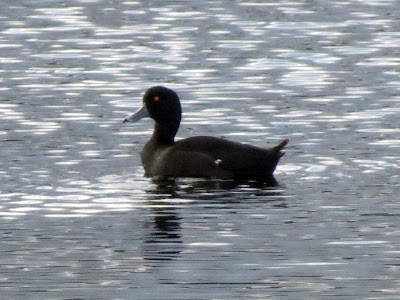Welcome to the Midnight Collective Broadsheet 89
Actively
supporting NZ’s endangered wetland birds
 |
| Scaup - Waikanae Estuary early August |
Our waterbirds have been giving us a
taste of early spring as their behaviour starts to liven up before they pair
off and begin to nest. Scaup started arriving back at the Waikanae estuary in
early August (they disappeared in early April) and we now have a dozen or so on
various wetlands in the area. Meanwhile to our great surprise another dabchick
has turned up in the same lagoon and this has caused all sorts of trouble for
the newly paired up residents and for us in trying to work out what was going
on.
 |
| Male dabchick |
All the interaction was occurring some
distance away in very grey light, and even as we captured it on film we had
trouble figuring out the dynamics of this because they disappear under water.
 |
| 3's a crowd -female in middle (possibly) |
 |
| Going for it... |
At first we thought another female had disturbed the couple and that two
females were fighting it out but on closer examination something more intriguing
appeared to be going on, with the female seeing an intruding male off. Both were very agitated and lots of bonding reinforcement took place after
the fracas. But this is our opinion; see what you think when watching the first
part of this clip.
It appears to confirm once again, how
large a part the females play in mate selection (and retention). This female
flying at the intruder with snapping beak - both above and below water…
It remains a mystery how these diving waterbirds get around these separated wetlands
because they are rarely seen flying, but their fractious behaviour has sent both species lifting into the air and you can see from the video how cumbrous they are.
 |
| Scaup flying |
It has been thought that they fly during
the night because they will suddenly shift habitat, but as you can see, they
barely lift off the surface of the water. The dabchicks, somewhat like
albatross (very elegant flyers, though they mostly glide), are kept busy
paddling across the surface of the water in their efforts to get traction into
the air. And when they do achieve lift off, they keep close to the surface, so
it’s not easy to see how they would fly safely at night over an urban
landscape.
And yet they must. When a dabchick turned
up at the dune lake two years ago, he (it was a male), spent sometime on the
small sister wetland across the Wharemauku, but must have flown over the
blackberry to get to the dune lake for we found him one morning having shifted
home. He was there about 4 weeks before moving on.
We are now into the chill, miserable,
(for New Zealand), end of winter, though with an occasional taste of better
weather thrown in, so all these animals are in a very sportive, bolshy, temper
as they begin pairing off. And here we see part of the rare pleasure of living
in these parts, at least for anyone with a strong connection to their local native
environment. For these are not only relatively rare endemic birds, but still
wild, their behaviours and lives unmodified by close contact to human beings.
Though the expressway has taken a big
bite out of their natural habitat. Combine this with the development pressure for sites overlooking the
water, and these animals will be pushed further and further out of the centre of
things. And how short sighted is this for a District that brands its self as
‘The Nature Coast’.
Track we were listening to while posting this - we are back with The Keil Isles - Please Don't Tease.
No comments:
Post a Comment